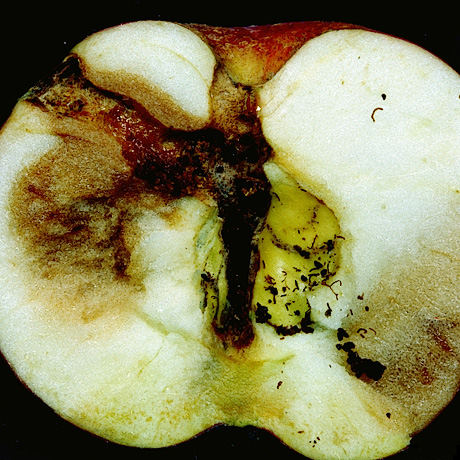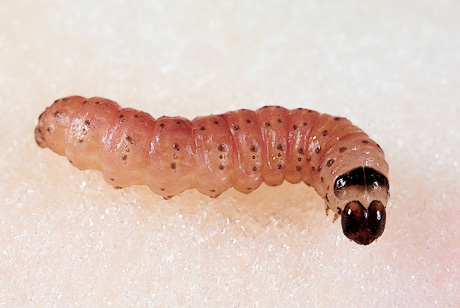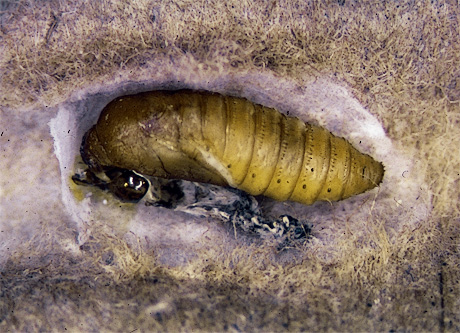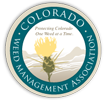
Codling Moth
Damage caused by the codling moth
The larvae of the codling moth tunnels into fruit and makes apples wormy. It is the most important insect pest of apples and pears, and is sometimes found in cherries, peaches and crab apples. The larvae create tunnels in the fruit with brown moth excrement at the entry and exit point of the tunnels.
 Clemson University - USDA Cooperative Extension Slide Series, Bugwood.org
Clemson University - USDA Cooperative Extension Slide Series, Bugwood.org
How to identify the codling moth
The adult codling moth (Cydia Pomonella) is about 1/2" long, grayish with white bands.The tips of the wings are a copper color. They are active at night like most moths.
The larvae of the codling moth are creamy white to light pink with a brown or black head. They are often found in pears and apples.
 Clemson University - USDA Cooperative Extension Slide Series, Bugwood.org
Clemson University - USDA Cooperative Extension Slide Series, Bugwood.org
Life cycle of the codling moth
Female codling moths lay their eggs on fruit an leaves of the apple and pear tree. The eggs hatch in 6 to 14 days.
The caterpillars start tunneling into the fruit within 24 hours. They tunnel through the fruit to get to the seeds which is their preferred food. When full grown the caterpillars tunnel back out of the fruit and spin a cocoon in the bark or debris at the base of the tree where they pupate over the winter.
Adult codling moths emerge from their cocoons in the spring, mate and lay eggs.
Some codling moths pupate in late spring or early summer and go through a second generation in one year.
 Gyorgy Csoka, Hungary Forest Research Institute, Bugwood.org
Gyorgy Csoka, Hungary Forest Research Institute, Bugwood.org
How to control the codling moth
The codling moths have many natural predators, including wasps, assasin bugs, minute pirate bugs and green lacewing larvae that can be used to control the pest.
The codling moth larvae prefers a protected spot to enter the fruit, like the ends of the fruit or a place where the fruit is touching something. Proper thinning of the fruit, so they don't touch, will reduce the likelyhood of codling moth damage.
Any fruit containing codling moth larvae should be removed and destroyed so those moths don't reach maturity and damage more fruit.
Removing possible pupating areas will reduce the number of codling moths. Mature caterpillars can be attracted to artificial pupating areas made of burlap or cardboard, then destroyed.
Fruits can be protected from codling moth damage by enclosing them in a paper bag when they reach 1/2" to 1" in diameter.
Insecticide sprays applied when the eggs are hatching will greatly reduce the damage from codling moths.
The codling moth granulosis virus applied to the fruits, before the eggs hatch, will kill colding moth larvae and is safe enough to be considered an organic technique.
 Whitney Cranshaw, Colorado State University, Bugwood.org
Whitney Cranshaw, Colorado State University, Bugwood.org
Other resources





